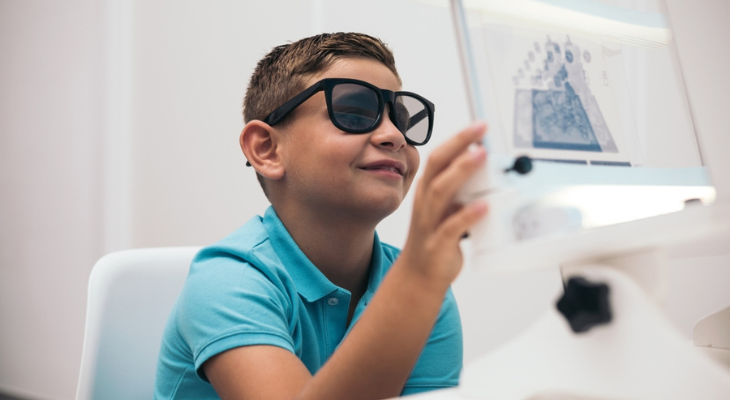
Is Vision Therapy an Effective Treatment for Amblyopia?
Reading, writing, driving, or playing sports becomes difficult when your brain receives conflicting information from your eyes due to amblyopia (lazy eye). Luckily, vision therapy offers an effective way to improve vision for both children and adults with amblyopia.
What Is Amblyopia?
People with amblyopia rely on one eye for most of their vision. Normally, the brain combines the signals it receives from both eyes to create one clear image. Unfortunately, that's not possible if you you have amblyopia. Due to the confusing information received from the eyes, the brain eventually ignores the signals from one eye.
Amblyopia has several causes, including:
- Strabismus (Crossed Eyes). Misaligned eyes send slightly different signals to the brain. Both noticeable and slight misalignments can cause problems with vision.
- Cataract. Children who have cataracts at birth are more likely to develop amblyopia. Cataracts occur when the normally clear lens inside the eye becomes cloudy.
- Family History. You may be more likely to develop amblyopia if someone else in your family had the condition.
- Your Eyeglass Prescription. Significantly worse vision in one eye increases the amblyopia risk, as does severe hyperopia (farsightedness) or myopia (nearsightedness).
- Prematurity. Children who were born prematurely or have developmental disabilities have a higher risk of amblyopia.
Regardless of the cause, you may notice these problems if you have amblyopia:
- Poor Vision. Blurry and double vision are common symptoms of amblyopia.
- Depth Perception Issues. Amblyopia makes it difficult to see the world in three dimensions. You may struggle with clumsiness, have trouble judging distances, or find it difficult to catch or throw a ball accurately due to depth perception problems.
- Reading Difficulties. Have you noticed that it's easier to read if you squint or tilt your head? Squinting and head tilting make it easier to use your good eye. If you or your child have or had academic issues, reading problems caused by amblyopia could be a factor.
- Headaches and Fatigue. Your eyes must work harder than normal when you read or focus on objects. The resulting eyestrain can cause painful headaches and fatigue. In addition to feeling tired when you read, you may also notice problems with concentration.
How Vision Therapy Can Improve Amblyopia Symptoms
Vision therapy retrains your brain to accept information received from both eyes and helps the brain form new neural pathways. Neural pathways are networks that make it possible to send signals from one part of the brain to another.
Vision therapy also improves underlying conditions, like strabismus, that may have caused amblyopia. Although vision therapy is most effective when begun during early childhood, teenagers and adults can also benefit. Your vision therapist creates a therapy plan for you that may include hands-on activities and exercises, special lenses and filters, and even video games.
Vision therapy offers an alternative to eye patching or may be used in addition to patching in children. Patching involves placing a patch over the "good" eye to force the brain to recognize signals from the "bad" eye. According to a research study published in BMC Ophthalmology, adding vision therapy to the traditional treatment of part-time patching and optical correction was more helpful for children aged 7 to 10 than traditional treatment alone.
Research shows that vision in adults with amblyopia also improves after vision therapy. UC Berkeley researchers reported improvements in vision after study participants played an action video game with one eye patched. Vision improved after just 40 hours of play. Normally, it takes about 120 hours of vision therapy activities to notice an improvement. Visual acuity, or sharpness, improved by 30% for research subjects who played the video game.
In a study published in Clinical Optometry, adults who had anisometropic amblyopia, the type of amblyopia caused by very different prescriptions in each eye, showed significant improvements after vision therapy. In addition to playing video games, the study participants wore special lenses during vision therapy activities. The lenses helped them focus both eyes equally on objects.
Wondering if vision therapy could help your lazy eye symptoms? Contact our office to schedule an appointment with vision therapist.
Sources:
BMC Ophthalmology: Efficacy of Vision Therapy for Unilateral Refractive Amblyopia in Children Aged 7 – 10 Years, 1/31/2022
https://bmcophthalmol.biomedcentral.com/articles/10.1186/s12886-022-02246-9
Berkeley Research: Playing Video Games Helps Adults with Lazy Eye, 8/3/2011
https://vcresearch.berkeley.edu/news/playing-video-games-helps-adults-lazy-eye
Clinical Optometry: Visual Acuity Improvements in Adult Anisometric Amblyopes After Active Vision Therapy, 10/15/2020
https://www.ncbi.nlm.nih.gov/pmc/articles/PMC7571576/
American Optometric Association: Amblyopia (Lazy Eye)
https://www.aoa.org/healthy-eyes/eye-and-vision-conditions/amblyopia?sso=y
